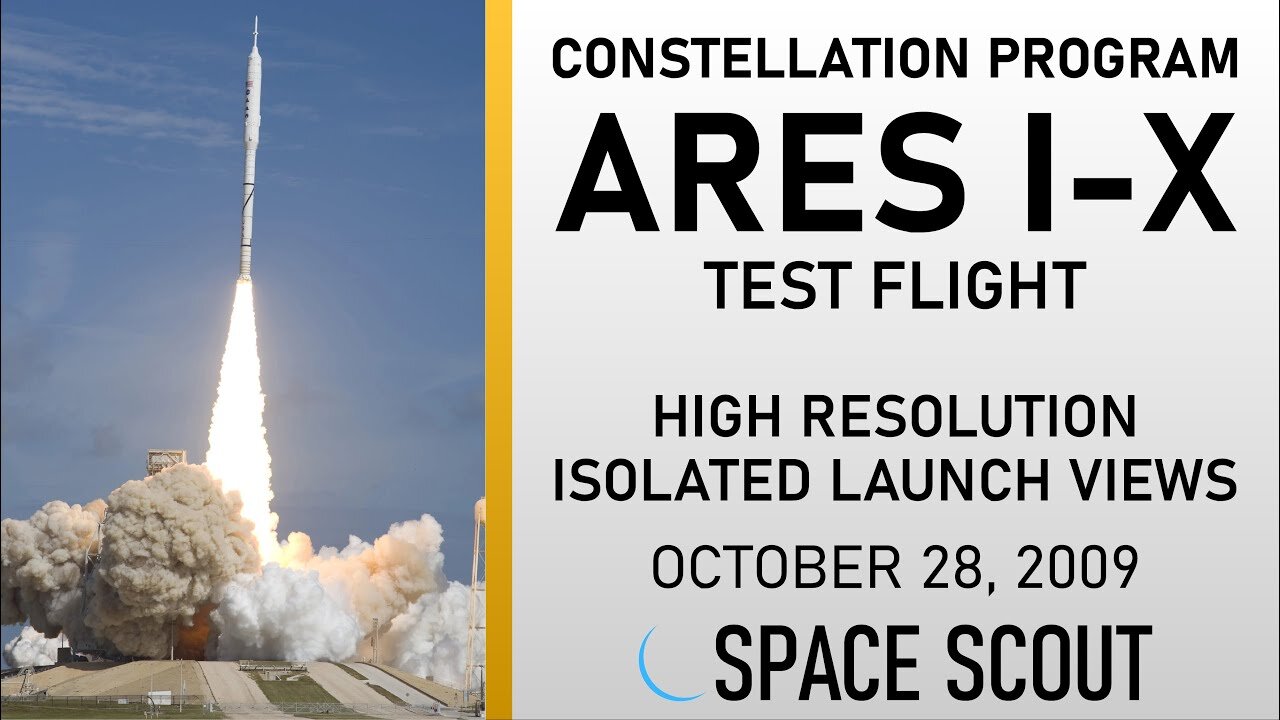Premium Only Content

Ares I-X Flight Test Rocket Launches - Nasa Collection
The Ares I-X Flight Test was a crucial milestone in NASA's Constellation program, aimed at developing a new generation of crewed spacecraft and launch vehicles. The Ares I-X launch took place on October 28, 2009, from Kennedy Space Center's Launch Complex 39B in Florida, United States.
Launch Vehicle:
The Ares I-X launch vehicle was a prototype of the Ares I rocket, which was intended to be the crew launch vehicle for NASA's Orion spacecraft. It was a two-stage configuration, with a four-segment solid rocket booster as the first stage and a dummy upper stage resembling the Orion spacecraft's upper stage. The dummy upper stage included an active launch escape system for safety testing.
Objectives:
The primary objectives of the Ares I-X Flight Test were to gather data on the vehicle's aerodynamic performance during ascent, particularly the interaction between the first and second stages, and to test the performance of the launch abort system. The data collected from this test would be crucial in refining the design of the Ares I rocket for future crewed missions.
Launch and Flight:
The Ares I-X lifted off from the launch pad with a thunderous roar, its four-segment solid rocket booster propelling the vehicle off the ground with immense force. As it ascended, the prototype rocket transitioned through various stages of flight, experiencing changes in aerodynamic pressures and forces. This provided NASA engineers with valuable data on the vehicle's behavior under different flight conditions.
Parachute Recovery:
After the test flight, the dummy upper stage and its launch abort system were jettisoned and fell back to Earth. To ensure a safe recovery, the stage was equipped with parachutes that deployed to slow its descent. These parachutes gently guided the stage to a controlled splashdown in the Atlantic Ocean, where recovery teams were ready to retrieve the hardware for further analysis.
Legacy:
The Ares I-X Flight Test provided NASA with valuable insights into the performance and behavior of the Ares I launch vehicle under real flight conditions. The data gathered from this test influenced the design and development of the subsequent Space Launch System (SLS), which replaced the Constellation program. The SLS continues to be NASA's flagship rocket for future crewed and uncrewed missions, including the Artemis program aimed at returning humans to the Moon and beyond.
In summary, the Ares I-X Flight Test was a significant step in NASA's efforts to develop a new crew launch vehicle and spacecraft system. It demonstrated NASA's commitment to advancing space exploration technology and laid the foundation for future endeavors in human spaceflight.
-
 LIVE
LIVE
SpartakusLIVE
9 hours agoThe BADDEST Duo in WZ Exhibits PEAK Physique || Duos w/ Sophiesnazz to start, quads later
5,957 watching -
 2:49:37
2:49:37
RattlesnakeTV
21 hours ago $0.29 earnedLIVE DEBATE! Lord Jake vs Crazy Feminist
21.5K11 -
 4:00:42
4:00:42
Badlands Media
12 hours agoThe Narrative Ep. 35: Codex of Truth
87.9K44 -
 3:55:56
3:55:56
Due Dissidence
15 hours agoSchmuley TRASHES Shapiro, Maxwell Sings For Pardon, Uhuru Doc Preview - Live From St. Louis!
44.3K44 -
 LIVE
LIVE
Lofi Girl
2 years agolofi hip hop radio 📚 - beats to relax/study to
465 watching -
 2:23:21
2:23:21
PandaSub2000
5 days agoMadison VR (Part 4) | PSVR 2000 (Original Live Version)
23.7K2 -
 2:34:32
2:34:32
Badlands Media
5 days agoCODEX 9/11
303K263 -
 1:53:43
1:53:43
Nerdrotic
10 hours ago $0.32 earnedMysteries of 3I/ATLAS | Forbidden Frontier #113
58.4K5 -
 2:04:21
2:04:21
vivafrei
1 day agoEp. 278: D.C. Peace Wave! Big Tish & Nipple Judge SPANKED! "Maryland Man" Trafficker FREE & MORE?
115K138 -
 3:02:42
3:02:42
Damysus Gaming
6 hours agoBorderlands 3 - Part 8 - FL4K Time | Children of the Vault be Warned!
25.4K